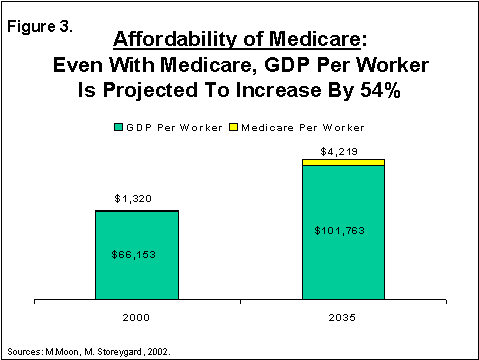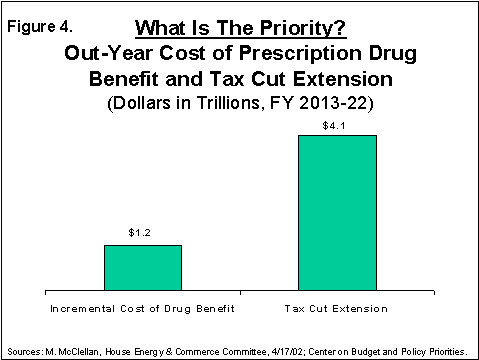

 |
 |
|
|
|
||
| SEARCH | SUBSCRIBE | ||
Some related articles : AARP
Wants Bigger Role in Prescription Drug Cases - Global Action on |
|
 |
Our ability to achieve that goal is enhanced
by Medicare's fiscal performance.
Health care is expensive. But Medicare is as good and often
better than the private sector in managing cost growth. Faced with high
rates of expenditure growth and trust fund problems in the 1990s, policy
makers responded with payment rate changes that dramatically slowed
Medicare cost growth. In the past 5 years, Medicare's average growth rate
per beneficiary was significantly lower than that of the private sector or
the Federal Employees' Health Benefits Plan (FEHBP) (Figure 1).
Although the cost of health care is an issue for the entire nation
(not Medicare alone) and there will always be controversy about whether
Medicare is paying too much or too little, recent experience demonstrates
that policymakers have the tools they need to manage Medicare's costs.

The Medicare baseline projections for the
next 10 years recognize the effectiveness of these tools for the future as
well as the past. Both the
Congressional Budget Office (CBO) and the Office of Management and Budget
(OMB) are projecting average Medicare growth rates per beneficiary that
are low: 4.8 and 3.6 percent for the next 10 years[i]
- at or below medical inflation (4.4 percent from March 2001 through 2002)
and well below projected private premium growth projections (6.1 percent
for 2002 through 2010) (Figure 2). Medicare
has not grown this slowly for any past 10-year period.[ii]
Similarly, in its most recent report, the Medicare Trustees project
that the Hospital Insurance Trust Fund will be solvent through 2030.
Few previous Trustees' projections have been more optimistic than
this.

Our ability to support the Medicare program goes well beyond the strength of the Trust Fund. Most critical to that support is the strength of our economy. A recent analysis by Marilyn Moon suggests how important it is to examine projected Medicare cost growth in the context of overall economic growth. Her analysis demonstrates that future taxpayers will be substantially better off than current taxpayers, even taking Medicare cost growth into account. By her estimates, GDP per worker will rise by 53.8 percent between 2000 and 2035, even taking into account Medicare spending projections. Without Medicare, this projected increase in GDP per worker would be 57 percent (Figure 3). Stated simply, this nation's economy will likely grow strongly enough to pay for Medicare beneficiaries' future health care costs.[iii]
A Prescription Drug Benefit Is Medicare's Most Pressing Need
Medicare's biggest challenge is not better managing what it already covers; instead, it is covering what it currently excludes: prescription drugs. Prescription drugs have become an integral part of modern medicine, often preventing disease, managing chronic illness and even curing certain conditions. Seniors and people with disabilities disproportionately rely on prescription drugs. According to recent CBO testimony, Medicare beneficiaries account for 15 percent of the population but 40 percent of the spending on outpatient prescription drug spending. The average Medicare beneficiary will spend over $2,400 on prescription drugs next year, and nearly one in five beneficiaries (17%) are expected to spend more than $5,000 by 2005. Over the next decade, Medicare beneficiaries are projected to spend $1.8 trillion on prescription drugs – with or without a Medicare drug benefit.[iv]
Not only do Medicare beneficiaries have a greater need for prescription drugs; they also disproportionately lack coverage for it. Depending on how one counts, anywhere from 25 to 42 percent of Medicare beneficiaries lack prescription drug coverage for all or part of the year.[v] This problem is worse for older and rural beneficiaries. Over time, most experts suggest that the proportion of beneficiaries who lack drug coverage will grow as the cost of Medigap policies with drug coverage rises, the drug benefits in Medicare managed care plans become less generous and more scarce, and employers continue to cut back on retiree health coverage.
A Prescription Drug Benefit is Affordable
There is a widespread consensus on the need for a Medicare prescription drug benefit. What is lacking is agreement on what constitutes an adequate benefit - the distribution of prescription drug costs between seniors and taxpayers –, its affordability, and its priority.
Substantial differences exist in the
scope of proposed prescription drug benefits.
This Committee allocated $350 billion over 10 years for a benefit;
the Senate Budget Committee allocated $500 billion. And it would cost an estimated $750 billion over 10 years to
provide seniors with a benefit comparable to the benefit members of
Congress receive through the Federal Employees Health Benefits Program.
Recently, Administration testimony
implied that the nation cannot afford a $750 billion drug benefit: "The
excess costs of $400 billion in the first 10 years would balloon to $1.2
trillion in the next ten, just when the Baby Boomers are counting on
Medicare." The testimony
continues to claim that a drug benefit of this size would, by 2030, be "equivalent
to a tax of $2,170 (in today's dollars) on every working American."[vi]
But, the Administration's analysis suggests that its concern is not affordability, it is priorities. In fact, combining what the President's budget spends on Medicare and its tax cuts, the budget already includes $750 billion that could be applied fully to a Medicare drug benefit.[vii] Moreover, in the second decade, the extension of the tax cut would cost, according to the Center on Budget and Policy Priorities[viii], $4.1 trillion, compared to the Administration's estimated $1.2 trillion cost of the additional amount of drug coverage (Figure 4). And, it is not until well after 2020 that the cost per worker of a drug benefit exceeds that of the cost per worker of a tax cut, according to a forthcoming analysis by the Center on Budget and Policy Priorities; in 2020, the average tax cut cost per worker ($1,579 in 2002 dollars) would still exceed that of the cost per worker of the entire $750 billion drug benefit ($1,064). Thus, it is hard to reconcile the claimed priority given to a prescription drug benefit with the proposal to eliminate the revenues needed to support it.

On the source of funding, the Administration has challenged the use of
both the Hospital Insurance Trust Fund and general revenue financing.
Specifically, it claims that funding a prescription drug benefit
from the Trust Fund would cut its insolvency in half, and that funding it
through a mechanism like the Supplemental Medical Insurance Trust Fund
represents "accounting gimmicks."[ix]
Corroborating this concern, the Administration omitted general
revenue funding from its displays of the current Medicare program's
financial health in its budget documents, despite its legal, 35-year
history of supporting Part B services.
On prescription drug financing, no one has proposed the first, and
the Administration itself has used the second.
General revenue funding supports outpatient services in Medicare
today; it is a more progressive way to finance benefits than a payroll tax
increase; and, while weakened, the budget outlook is strong enough to
support this use of funds. The
fact that the Administration's own $190 billion Medicare allocation is
drawn from general revenues raises the question of where and, more
importantly, why the Administration is drawing lines about legitimacy of
the funding of this critical benefit.
Conclusion
The
facts suggest that the biggest challenge facing Medicare today is not its
cost growth or even its long-term affordability but its lack of a
prescription drug benefit. Medicare
has contributed and will, in the immediate future, continue to contribute
to longer and healthier lives for our nation's elderly.
But its historical protection of seniors against the economic
consequences of high health care costs is now threatened by rising drug
costs and its lack of a drug benefit.
By 2012, Medicare beneficiaries are projected to spend more on
prescription drugs than Medicare is projected to spend on all Part B
services combined, according to CBO.
A $750 billion prescription drug benefit would cover less than half
of prescription drug costs of Medicare beneficiaries.
It costs far less, over time, than the extension of the tax cut.
The question here is not affordability, it is priorities.
FAIR USE NOTICE: This page contains copyrighted material the use of which has not been specifically authorized by the copyright owner. Global Action on Aging distributes this material without profit to those who have expressed a prior interest in receiving the included information for research and educational purposes. We believe this constitutes a fair use of any such copyrighted material as provided for in 17 U.S.C § 107. If you wish to use copyrighted material from this site for purposes of your own that go beyond fair use, you must obtain permission from the copyright owner.